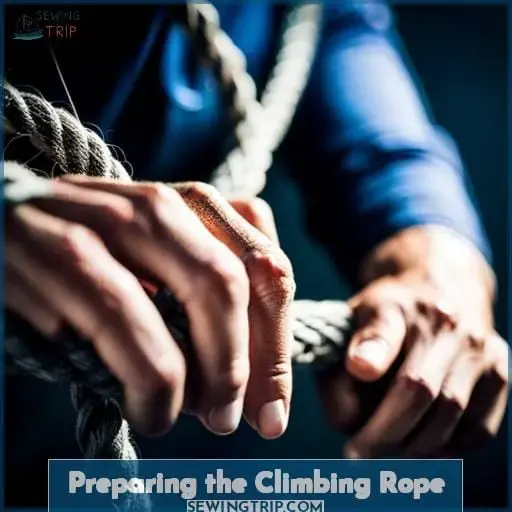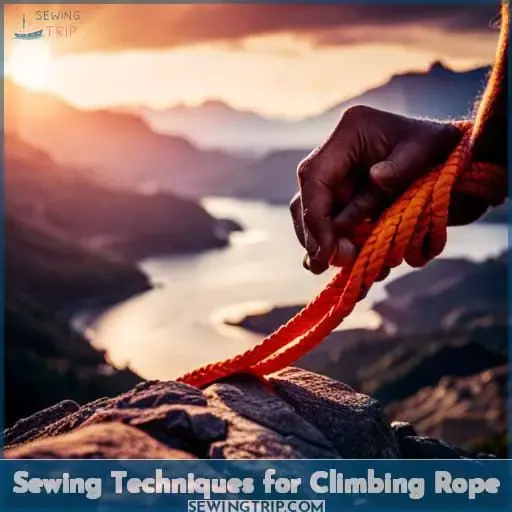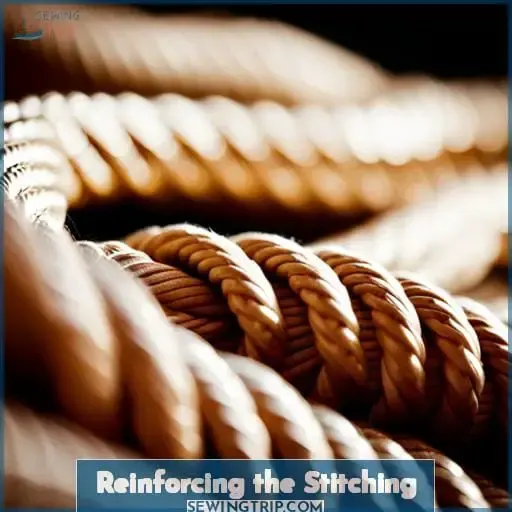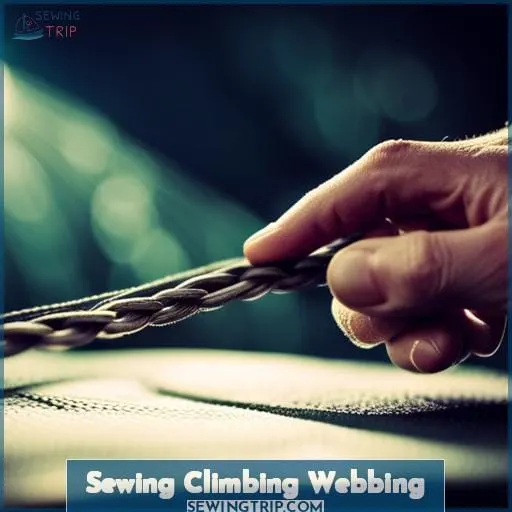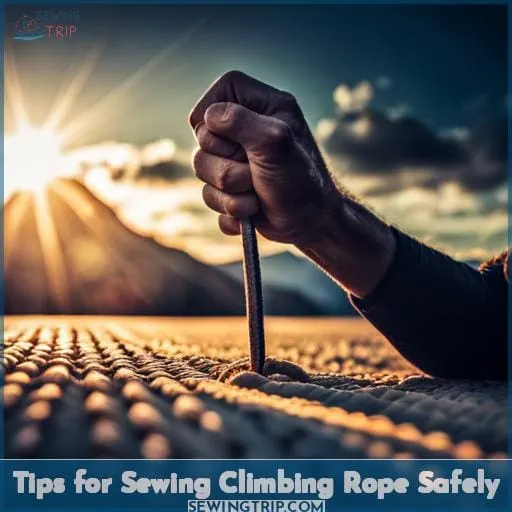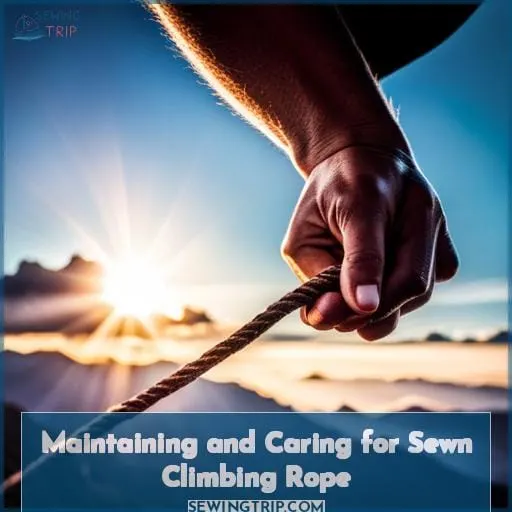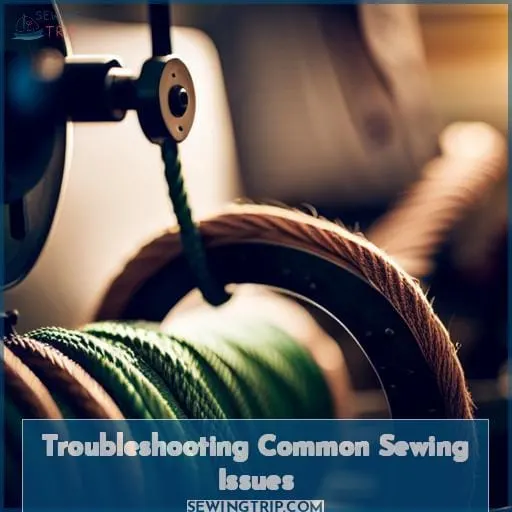This site is supported by our readers. We may earn a commission, at no cost to you, if you purchase through links.
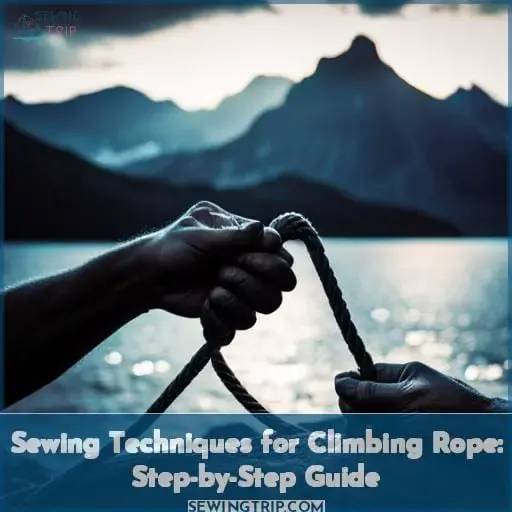 Imagine yourself conquering new heights, scaling rock faces with confidence and precision. To truly master the art of climbing, it’s essential to have a strong understanding of your equipment.
Imagine yourself conquering new heights, scaling rock faces with confidence and precision. To truly master the art of climbing, it’s essential to have a strong understanding of your equipment.
In this step-by-step guide, you’ll learn the sewing techniques that will keep you safe on your ascent. From choosing the right machine to reinforcing stitches and creating attachments, this article will empower you with the knowledge needed for successful rope maintenance and customization.
Table Of Contents
- Key Takeaways
- Preparing the Climbing Rope
- Choosing the Right Sewing Machine
- Selecting the Appropriate Thread
- Sewing Techniques for Climbing Rope
- Reinforcing the Stitching
- Creating Attachments and Loops
- Sewing Climbing Webbing
- Tips for Sewing Climbing Rope Safely
- Maintaining and Caring for Sewn Climbing Rope
- Troubleshooting Common Sewing Issues
- Frequently Asked Questions (FAQs)
- Conclusion
Key Takeaways
- Inspect and clean the climbing rope thoroughly before sewing.
- Use an industrial machine or modify a home machine for sewing climbing ropes.
- Experiment with different sewing techniques and thread colors for visual appeal.
- Reinforce stitching with double or triple zig-zag stitches and apply protective treatments for durability.
Preparing the Climbing Rope
Before you begin sewing your climbing rope, it’s important to properly prepare the rope by cleaning and removing any factory tape.
Rope preparation is crucial for ensuring a successful sewing procedure. Start by inspecting the climbing rope for any dirt or debris that may affect the stitching process. Use a mild detergent and water solution to gently clean the surface of the rope, making sure to rinse thoroughly and allow it to dry completely before proceeding with sewing.
Next, check your machine’s compatibility with climbing ropes. Ensure that your machine can accommodate thicker ropes without compromising its performance or damaging the equipment. Adjustments may be necessary, such as modifying presser foot clearance or adjusting tension settings.
Additionally, choose an appropriate thread for sewing climbing ropes. Opt for strong nylon threads that can withstand high tension without breaking easily.
By properly preparing your climbing rope through cleaning and selecting suitable materials and procedures, you’re taking essential steps towards achieving safe and effective stitching techniques in order to create reliable attachments on your gear while ensuring maximum safety during rock-climbing activities.
Choosing the Right Sewing Machine
Now that you’re ready to start sewing your climbing rope, it’s important to choose the right sewing machine.
Consider the compatibility of your machine with the size and thickness of climbing ropes. You may need to make adjustments or modifications, such as increasing rope clearance, in order to properly sew the ropes.
Additionally, pay attention to tension and trimming techniques when starting the coil and consider how different handles and shape considerations can impact the finishing and customization process.
Machine Compatibility: Adjustments and modifications.
To ensure successful sewing of climbing rope, consider machine compatibility by making adjustments and modifications.
Industrial machines are often suitable for handling climbing ropes without modification.
However, if using a household sewing machine, you may need to increase rope clearance by adjusting the presser foot linkage or modifying the presser foot.
These modifications will help accommodate the thickness and stiffness of climbing rope while avoiding any sewing restrictions that may arise during your project.
Starting the Coil: Tension and trimming techniques.
Adjust the tension on your sewing machine to create a zig-zag pattern between two parallel strands of retired rock climbing rope, as you begin starting the coil for your rope bowl.
Trim back the core of the climbing rope to avoid a hole in the center of the spiral. Cutting it on a diagonal will ensure a smooth transition from rope to point, forming the base of your bowl.
- Adjust tension for zig-zag pattern
- Trim core at an angle
- Form base of bowl
Finishing and Customization: Handles and shape considerations
Now let’s explore how to finish and customize your climbing rope project, specifically focusing on handles and shape considerations when choosing the right sewing machine for the job.
When it comes to adding handles or modifying the shape of your climbing rope, there are a variety of options available.
- You can choose from different handle styles such as loops or knots.
- Consider shaping techniques like tapering or flaring.
Additionally, you can personalize your project with unique designs using various sewing techniques.
Take into account environmental considerations when selecting materials for customization.
| Handle Options | Shape Modification | Personalization Ideas |
|---|---|---|
| Loops | Tapering | Unique stitching patterns |
| Knots | Flaring | Embroidery |
Selecting the Appropriate Thread
Now let’s talk about selecting the appropriate thread for sewing climbing rope.
Choosing a strong and durable thread is essential to ensure the longevity and reliability of your sewn attachments. Consider using strong nylon or other heavy-duty threads that can withstand the demands of climbing activities.
Take into account factors such as tension adjustments, zig-zag patterns, and trimming techniques to achieve optimal results in creating secure connections with your rope projects.
Choosing the right thread
When selecting the appropriate thread for sewing climbing rope, it’s important to consider factors such as strength and compatibility with your machine.
- Choose a strong nylon or other durable thread that can withstand the rigors of outdoor use.
- Consider the thickness of the thread, ensuring it matches well with your machine’s capabilities.
- Additionally, explore color options that suit your preferences and aesthetics while still maintaining durability considerations for long-lasting stitches on climbing rope.
Machine compatibility and adjustments
To ensure successful sewing of climbing rope, consider your machine’s compatibility and make necessary adjustments for selecting the appropriate thread.
Industrial sewing machines may not require modifications, but home machines might need adjustments for rope clearance.
Choose a strong nylon or similar thread suitable for weaving ropes.
Take into account the thickness of the climbing webbing, typically around 3mm, when selecting your thread.
Finishing and customization
To achieve a polished finish and add personal touches to your sewn climbing rope projects, selecting the appropriate thread is essential.
The right thread will ensure durability and enhance the overall aesthetic of your finished product.
Consider customization options such as handle variations or personalized finishes when choosing your thread.
Keep in mind shape considerations and machine modifications that may be necessary for achieving your desired results.
With these sewing techniques, you’ll create a one-of-a-kind climbing rope masterpiece.
Sewing Techniques for Climbing Rope
Now, let’s talk about the sewing techniques you can use for climbing rope.
There are a few different methods to consider:
- Zig-zag stitching
- Lacing
- Weaving
Each technique has its own advantages and challenges, so it’s important to choose the one that best suits your needs and preferences.
Whether you’re repairing a damaged rope or creating new gear from retired ropes, these sewing techniques will help ensure strong and reliable connections in your climbing equipment.
Zig-zag Stitching
How can you achieve a secure and durable stitch when zig-zag stitching climbing rope?
With the right technique, you can create stunning patterns and designs that enhance both the aesthetic appeal and performance of your rope.
- Pattern Variations: Experiment with different arrangements of zig-zag stitches for unique visual effects.
- Color Choices: Use contrasting thread colors to make your stitching stand out.
- Texture Options: Adjust the tension on your machine for varied textures in your sewn patterns.
Lacing and Weaving
When lacing and weaving climbing rope, you can create intricate patterns and secure connections by using various sewing techniques.
Braiding techniques allow for the formation of unique color patterns and textured designs on the rope surface. These techniques not only enhance the aesthetic appeal of your gear but also contribute to its durability.
However, it’s important to consider the environmental impact of these methods as they may retain dirt and debris more easily than other sewing techniques used in climbing rope projects like making rope bowls or harnesses.
Reinforcing the Stitching
First, reinforce the stitching on your climbing rope by using a double or triple zig-zag stitch. This will improve durability and overcome wear, ensuring that your connections are strong and secure.
To further enhance longevity, consider applying glue or a dry treatment to the stitching for added protection against moisture and abrasion.
Additionally, incorporating a bi-pattern design can help distribute stress evenly along the rope’s length, preventing excessive wear in specific areas.
By reinforcing the stitching on your climbing rope with these techniques, you can have confidence in its reliability during challenging climbs while prolonging its lifespan for continued adventures on rocky terrains.
Creating Attachments and Loops
Now that you have reinforced the stitching on your climbing rope, it’s time to move on to creating attachments and loops. These are essential for various climbing gear applications, allowing you to securely connect ropes or attach equipment.
There are different attachment methods and loop variations that you can utilize based on your specific needs.
To give you a clear understanding of these options, here is a table comparing sewn attachments versus spliced attachments in terms of strength:
| Attachment Method | Strength Comparison |
|---|---|
| Sewn | Excellent |
| Spliced | Exceptional |
As shown in the table above, both sewn and spliced attachments offer high levels of strength. However, it’s important to consider factors such as ease of creation and personal preferences when choosing between them.
When creating loops using sewing techniques for climbing rope, make sure to follow proper guidelines provided by manufacturers or experienced climbers. This will ensure the safety and reliability of your gear during outdoor activities.
Sewing Climbing Webbing
You can sew climbing webbing by following these step-by-step instructions.
Climbing webbing is a versatile and strong material that has various applications in the world of rock climbing. Whether you’re looking to create attachments, loops, or other projects with climbing webbing, sewing techniques are essential for ensuring its strength and reliability.
Start by selecting the right thread that matches the strength of your webbing. Use a zig-zag stitch on your sewing machine to securely attach the webbing together. Reinforce your stitching for added durability and peace of mind while on the wall.
Sewing climbing webbing allows you to customize it according to your needs and preferences, making it an essential skill for any climber looking to master their gear crafting abilities like Tommy Caldwell himself!
Tips for Sewing Climbing Rope Safely
To ensure your safety while sewing climbing rope, it’s important to follow these tips:
- Safety Precautions:
- Always wear protective gloves and goggles to prevent injury from sharp needles or flying debris.
- Equipment Maintenance:
- Regularly inspect your sewing machine for any loose screws or damaged parts that could affect its performance.
- Clean and oil the machine as recommended by the manufacturer.
- Stitch Reinforcement:
- Use a reinforced stitch pattern, such as a zig-zag stitch, to provide extra strength and durability to the sewn areas of the climbing rope.
By following these safety precautions, maintaining your equipment properly, and using appropriate stitching techniques, you can enhance both your skill development in sewing climbing webbing and ensure safe usage of eco dry ropes like Edelrid that resist grime retention.
Maintaining and Caring for Sewn Climbing Rope
Proper maintenance and care are essential for ensuring the longevity and performance of sewn climbing rope.
To keep your climbing rope in top condition, follow these guidelines:
- Regularly inspect the rope for any signs of wear or damage, such as fraying or cuts.
- If you notice any issues, make necessary repairs promptly to prevent further damage.
- Cleaning tips include using mild soap and water to remove dirt and grime from the surface of the rope while avoiding harsh chemicals that can weaken its integrity.
- After cleaning, ensure proper drying before storage to prevent mold or mildew growth.
- When storing your climbing ropes, coil them loosely without tension to avoid unnecessary stress on the fibers over time.
Troubleshooting Common Sewing Issues
If you encounter any issues while sewing climbing rope, troubleshooting common problems can help ensure a successful outcome.
When it comes to thread tension, make sure it’s properly adjusted for the specific rope and stitch pattern being used.
Needle choice is also important – using a needle designed for heavy-duty fabrics will help prevent breakage and ensure smooth stitching.
Additionally, consider adjusting the stitch length to accommodate the thickness of the climbing rope.
Another potential issue could be improper bobbin winding, which can lead to uneven stitches or thread breakage during sewing.
Take care to wind your bobbin correctly before starting your project.
By addressing these common sewing issues and following best practices when working with climbing ropes, you’ll be able to create sturdy and durable projects like spiral rugs or webbing attachments with ease.
Frequently Asked Questions (FAQs)
Can I use any type of rope for sewing projects, or does it have to be retired climbing rope?
For sewing projects with a touch of adventure, retired climbing rope is your ticket to liberation. It adds power and mastery to your creations, giving them an authentic outdoor edge.
Are there any specific safety precautions I should take when sewing climbing rope?
When sewing climbing rope, prioritize safety.
- Wear protective gloves to prevent injuries.
- Use a heavy-duty needle for the task.
Keep your workspace clear of distractions and focus on each stitch with intention and precision.
What are some alternative techniques or materials I can use if I don’t have access to a sewing machine?
If you don’t have a sewing machine, fear not! You can still get crafty with alternative techniques.
Try hand lacing or weaving to secure the climbing rope together.
Unleash your creativity and conquer the challenge!
Can I wash and clean the climbing rope before using it for sewing projects?
Before using climbing rope for sewing projects, it’s essential to wash and clean it.
Soak the rope in warm water with mild soap, gently scrubbing away dirt and grime.
Rinse thoroughly and hang to dry before repurposing.
Are there any special considerations or techniques for sewing thicker ropes or cords?
When it comes to sewing thicker ropes or cords, you’ll need a machine with enough clearance and power.
Industrial machines are your best bet for tackling those hefty ropes.
Take control of the challenge and conquer it!
Conclusion
In the exhilarating world of rock climbing, mastering the art of sewing climbing rope is crucial for your safety and success. By following this step-by-step guide, you have gained the knowledge and techniques needed to properly sew and maintain your climbing rope.
From preparing the rope to choosing the right machine and thread, reinforcing stitches, and creating attachments, you’re now equipped to confidently customize and care for your climbing gear.

